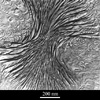Micrograph Library
Browse the libraryAdvanced searchSystemsCompositionsTechniquesKeywordsPhase diagramsHelpPreferencesAbout the micrograph libraryTerms of useContribute micrographs!FeedbackLinksCredits Print this page

Full Record for Micrograph 556

[137 KB]
View micrograph
.. in new window
View micrograph and record
.. in new window
You can also view and download the micrographs on Flickr
- Micrograph no
- 556
- Brief description
- Sheaf-like arrangement of lamellae in a blend of polyethylenes
- Keywords
- alignment, blend
 , polyethylene (PE), polymer
, polyethylene (PE), polymer  , quenching
, quenching  , spherulite
, spherulite 
- Categories
- Polymer
- System
- Polyethylene (PE)
- Composition
- LPE:BPE 3:1
- Standard codes
- Reaction
- Processing
- Blend (3:1) of linear and lightly branched polyethylenes. The blend was melted at 163 degrees C and then cooled to 126 degrees C for isothermal crystallisation
- Applications
- Polymer blends are commercially important materials. Blending very similar polymers can produce materials with improved properties.
- Sample preparation
- Technique
- Transmission electron microscopy (TEM)
- Length bar
- 200 nm
- Further information
- A replica of a 3:1 blend of linear with lightly branched polyethylenes (BPE has 26 branched per 1000 backbone carbon atoms) after isothermal crystallisation at a temperature at which the LPE but not the BPE can crystallise. This sample crystallised from a phase separated melt. There are clearly two lamellar types (The isothermal crystallisation makes the distinction clearer). The thick, LPE rich, lamellae crystallised in sheaf-like groups, from LPE rich droplets contained in a BPE rich matrix. The sheaf-like arrangement is representative of one of the initial stages in spherulite formation.
- Contributor
- Dr P J Barham
- Organisation
- Polymer Physics Group, Bristol University
- Date
- 03/10/02
- Licence for re-use
 Attribution-NonCommercial-ShareAlike 4.0 International
Attribution-NonCommercial-ShareAlike 4.0 International- Related micrographs

